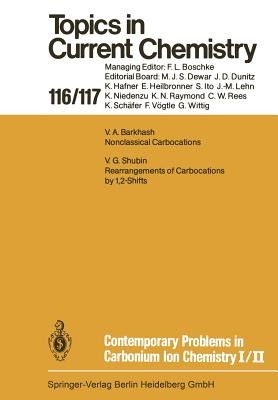
- Išsiųsime per 10–14 d.d.
- Leidėjas: Springer
- Metai: 2013
- Puslapiai: 348
- ISBN-10: 3662152886
- ISBN-13: 9783662152881
- Formatas: 17 x 24.4 x 1.9 cm, minkšti viršeliai
- Kalba: Anglų
- Extra -15 % nuolaida šiai knygai su kodu: ENG15
Contemporary Problems in Carbonium Ion Chemistry I/II (el. knyga) (skaityta knyga) | knygos.lt
Atsiliepimai
Aprašymas
In 1965 a book by P. Bartlett appeared under the title The Nonclassical Ions 1). The book is a collection of papers reprinted from various journals. The many reviews that have appeared since 2-22) are either antiquated (the book published in 1972 12) covers the literature mainly before 1968) or relatively biased (e.g., 3.4,10» on brief 2, 7,11). This review attempts to discuss the various points of view on the nonclassical carbocations. The main point is to establish the relative role of nonclassical and classical ions in various chemical processes. The author has followed P. Bartlett's advice 1) that when setting forth the achievements of the human mind one should see how we came to the modern understanding of a given problem ( ... how we know what we know). The theory of nonclassical ions offers an explanation of many unique chemical, stereochemical and kinetic peculiarities of bicyclic compounds. It has expanded our knowledge on chemical bonds in carbocations by introducing electron-deficient bonds (as in boron hydrides). It has accounted for many rearrangements of stable cations. As a side result our knowledge has been extended about ionization processes in a solution, as well as about stereochemical methods. 2 Main Terms of Nonclassical Carbocations In 1939 Hevell, Salas and Wilson 23) assumed an intermediate, bridge ion 2 to be formed when camphene hydrochloride 1 is rearranged into isobornyl chloride 3. This happened 17 years after Meerwein first postulated the intermediate formation of carbonium ions in chemical reactions.
EXTRA 15 % nuolaida su kodu: ENG15
Akcija baigiasi už 5d.01:44:12
Nuolaidos kodas galioja perkant nuo 10 €. Nuolaidos nesumuojamos.

- Leidėjas: Springer
- Metai: 2013
- Puslapiai: 348
- ISBN-10: 3662152886
- ISBN-13: 9783662152881
- Formatas: 17 x 24.4 x 1.9 cm, minkšti viršeliai
- Kalba: Anglų Anglų
In 1965 a book by P. Bartlett appeared under the title The Nonclassical Ions 1). The book is a collection of papers reprinted from various journals. The many reviews that have appeared since 2-22) are either antiquated (the book published in 1972 12) covers the literature mainly before 1968) or relatively biased (e.g., 3.4,10» on brief 2, 7,11). This review attempts to discuss the various points of view on the nonclassical carbocations. The main point is to establish the relative role of nonclassical and classical ions in various chemical processes. The author has followed P. Bartlett's advice 1) that when setting forth the achievements of the human mind one should see how we came to the modern understanding of a given problem ( ... how we know what we know). The theory of nonclassical ions offers an explanation of many unique chemical, stereochemical and kinetic peculiarities of bicyclic compounds. It has expanded our knowledge on chemical bonds in carbocations by introducing electron-deficient bonds (as in boron hydrides). It has accounted for many rearrangements of stable cations. As a side result our knowledge has been extended about ionization processes in a solution, as well as about stereochemical methods. 2 Main Terms of Nonclassical Carbocations In 1939 Hevell, Salas and Wilson 23) assumed an intermediate, bridge ion 2 to be formed when camphene hydrochloride 1 is rearranged into isobornyl chloride 3. This happened 17 years after Meerwein first postulated the intermediate formation of carbonium ions in chemical reactions.




Atsiliepimai